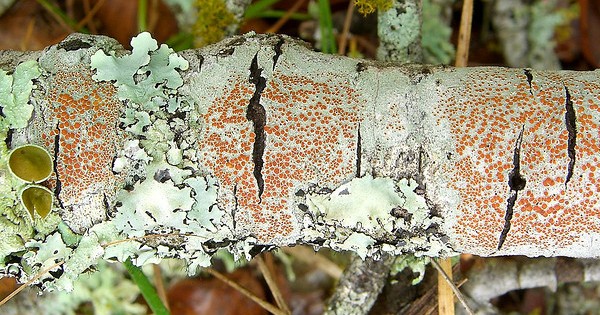
I grew up on a farm, so I’m hyperaware that farming is a matter of one species hoarding and husbanding another for later use as food. It’s a bit more complicated than that, but not much. Hoarding and husbanding could instead be for later use as labor (work dogs, work horses). Or for later use in the business of recreation (dog shows, horse races). This doesn’t mean that the species in captivity gets nothing from the relationship or that there isn’t kindness and affection between the two species (especially on nonfactory farms that graze their cattle, for instance). The captive species may even have lost any other means to live. But farms aren’t exactly democracies.
What is much more bizarre to contemplate is that farming is not exclusively a Homo sapiens endeavor. Damselfish cultivate algae. Beetles farm fungi. Termites and ants also farm fungi. Other ants raise aphids. And there are lichens.
Lichens, some 14,000 kinds worldwide, are a society of two species. One is a fungus. The fungus’s constant companion is either a green alga or a cyanobacterium. Most lichen fungi are the Ascomycetes (asko-MY-seats), the type that produce their spores in tiny sacs, called asci (ASK-eye). The green alga or cyanobacterium, called a photosynthesizing symbiont or photobiont for short, is the food-making party. It cooks water and carbon dioxide with sunlight to manufacture sugars and other carbohydrates. Fungi are more like us—unable to photosynthesize—and are related more closely to animals than to plants.
The lichen association of fungus and photobiont was once considered communal and agreeable. A mutual aid society in which the fungus afforded shelter and moisture while the photobiont made the food. And yes, lichens grow on rocks and old cars, on spots where a mere photobiont could not survive. (Lichens also grow on bark, pavement, pipe, fence posts … )
But the society of the lichen is not so nice. Most lichens, considered in terms of power relations, are dominated by the fungal party. Lichenologist Trevor Goward has asserted that lichens are “fungi that have discovered agriculture.” This according to the authority on lichens—and a gorgeous book it is—Lichens of North America by Irwin M. Brodo, Sylvia Duran Sharnoff, and Stephen Sharnoff.
Fungi farm photobionts, and this form of agriculture is called a lichen. Fungi grow by means of cells arranged in threads called hyphae (HI-fee). Lichen fungi grow their hyphae right into the bodies of their photobionts. When thus penetrated, the photobiont’s cell wall goes all porous and leaks food into the fungal body.
The photobionts are making food, and the fungi are eating the food. And the fungi are also eating the photobionts. “Is there, then, any reason,” Brodo asks, “to continue to regard lichens as examples of a true partnership or mutualism?” Of course the prudent farmer preserves enough stock to continue harvesting, year after year.
This is a mildly macabre sort of marriage. Still, lichens contribute quintessentially to the ecology of virtually every terrestrial habitat. Lichens are hypersensitive and thus index levels of pollution. (If you don’t have lichens, you do have pollution.) Lichens break down rocks and logs and dead leaves, making soil. They (or their cyanobacteria) fix nitrogen. They provide food for caribou, et al. They provide nesting matter for birds. They provide trees for the little landscapes through which model trains chug.
Lichens possess their own kind of beauty. There are three basic types. The foliose type looks like little lettuce leaves (they are not real leaves). Fruticose lichens have cups or stalks or they hang from trees like pale green hair. Crustose lichens are crusts—orange or red or yellow or white.
Learning to identify lichens is a big process—I’ve only just begun. But now that I have my lichen-detector switched to on, I see these fungal farms just about everywhere I go.

